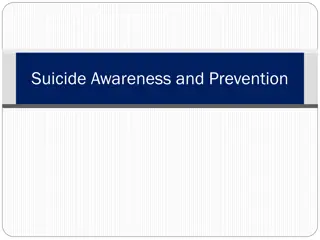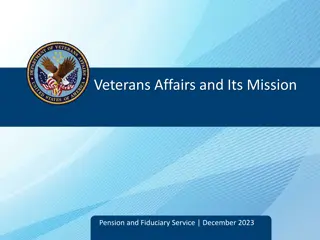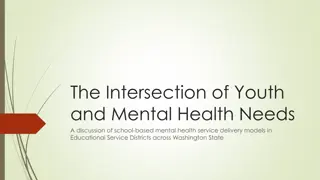Lessons Learned from Utilizing ACT to Understand and Prevent Suicide in Veterans
Dr. Debbie Sorensen, from Denver V.A. Medical Center, presented on utilizing Acceptance and Commitment Therapy (ACT) to comprehend and address suicidal ideation (SI) among veterans. The VA training program in ACT for depression showcased positive outcomes in reducing SI and depression symptoms. The importance of experiential acceptance and mindfulness in the process was highlighted. Practical insights and challenges were also discussed, emphasizing the significance of safety planning and therapist support in working with suicidal patients.
Download Presentation

Please find below an Image/Link to download the presentation.
The content on the website is provided AS IS for your information and personal use only. It may not be sold, licensed, or shared on other websites without obtaining consent from the author.If you encounter any issues during the download, it is possible that the publisher has removed the file from their server.
You are allowed to download the files provided on this website for personal or commercial use, subject to the condition that they are used lawfully. All files are the property of their respective owners.
The content on the website is provided AS IS for your information and personal use only. It may not be sold, licensed, or shared on other websites without obtaining consent from the author.
E N D
Presentation Transcript
Debbie Sorensen, Ph.D. Denver V.A. Medical Center debbie.sorensen@gmail.com Panel: Utilizing ACT to Understand and Prevent Suicide ACBS Conference, June 2016, Seattle
Lessons Learned from the VA Training Program in ACT National training program in ACT for Depression for VA clinicians. 3-Day training workshop followed by 6 month consultation period. Complete ACT for Depressed Veterans protocol with two veterans.
Lessons learned from the VA Training Program in ACT: The Data BDI-II results indicated a reduction in SI from baseline to final session Veterans with and without SI showed reduction in depression symptoms Experiential acceptance and mindfulness were important processes
Lessons Learned from the VA Training Program in ACT: Impressions of a Training Consultant ACT can provide a useful and effective framework for working with suicide Potential pitfalls I ve seen Reluctance to do Creative Hopelessness with suicidal patients Seeking an ACT intervention to solve the problem/fix it Getting into convincing/ power struggle with client about staying alive Importance of support for therapist-evocative for new ACT clinician Safety planning More paperwork , or can it be a useful tool?
SAFETY PLAN Step 1: Warning Signs Step 2: Internal Coping Strategies Step 3: Social Contacts Who May Provide a Distraction Step 4: People Who Can Help Resolve the Crisis Step 5: Contacting Professionals and Agencies Step 6: Reducing the Potential Use for Lethal Means Step 1: Awareness Steps 2-5: Can be used to increase behavioral flexibility Make it useful, can be similar to a functional analysis Collaborative process
A functional/contextual perspective Conceptualizing/assessing suicide is an ongoing process, not a one-time event. Understanding the context and function- critical to understanding the meaning of the behaviors Thinking about suicide emotional control strategy/avoidance? The act of talking to a therapist about suicidal thoughts Actions taken toward self-harm Think Behaviorally Inflexible repertoire of responding to emotional pain Consider the context/function in terms of clinical response, as well. What is being reinforced by clinician? Do we (unintentionally) shame people who talk openly about suicide?
Possibly relevant* ACT processes and techniques** *Depending on the context, of course! **Caveat: Don t rely too much on techniques, or use them solely to relieve your own discomfort. More important to connect with the human being who is suffering enough to consider suicide.
Possibly relevant* ACT processes and techniques** Acceptance Creative Hopelessness Willingness to experience emotional pain Awareness Functional analysis to increase understanding of the context Mindfulness Perspective-taking/self as observer Defusion Normalizing and understanding thoughts of suicide Not taking thoughts too literally Urge surfing Values and Committed Action Choose life-affirming actions Building a life worth living
A few words of wisdom for treating suicidal clients Go there! Be courageous. Create a compassionate, non-shaming space to explore what s happening. Be clear and direct about ethical/reporting issues related to potential self- harm, and from there, invite the client to talk openly. Be aware of your own reactions/behavior patterns when addressing suicide. Take care of yourself! This is very hard work that we do
Thank you! Robyn Walser and the VA Training Consultants in ACT. *JaymeeDow & Jen Fabrizio My consultees from the training program, who have taught me so much about doing therapy. The veterans who let me go there with them. Sean Barnes and my fellow panelists. My Contact Info: Debbie Sorensen, PhD. Denver V.A. Medical Center debbie.sorensen@gmail.com debra.sorensen@va.gov 303-399-8020 ext. 5028
Discussion Questions How far should you go into Creative Hopelessness with suicidal clients? Do you titrate Creative Hopelessness, or does that gloss over a key part of ACT therapy? How about the funeral or tombstone exercises? Do you dare use them, or is the death aspect too provocative? How can we best promote acceptance of suicide-related thoughts without inadvertently encouraging suicidal behavior?
Discussion Questions What personal responses do you have to suicide talk in therapy, and how does that influence your decision-making process? How do you balance ethical guidelines and pressure to keep clients alive with addressing suicide as a clinical issue? In what other ways can ACT be helpful for addressing suicide?























